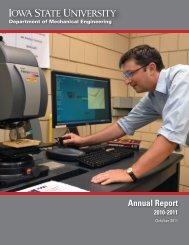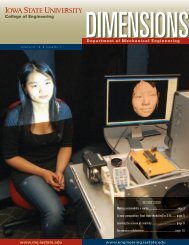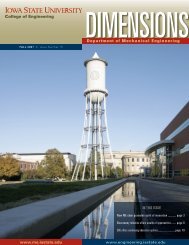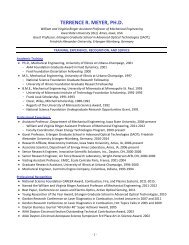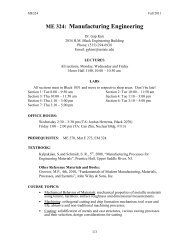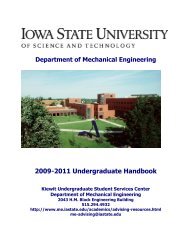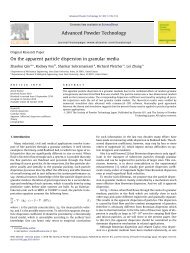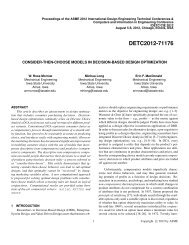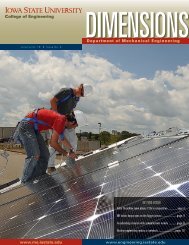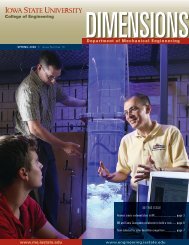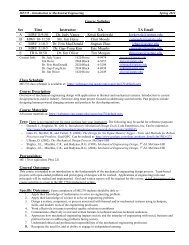Spring 2000 - Mechanical Engineering - Iowa State University
Spring 2000 - Mechanical Engineering - Iowa State University
Spring 2000 - Mechanical Engineering - Iowa State University
You also want an ePaper? Increase the reach of your titles
YUMPU automatically turns print PDFs into web optimized ePapers that Google loves.
<strong>Mechanical</strong> <strong>Engineering</strong><br />
SPRING <strong>2000</strong> • VOLUME 10, NUMBER 1<br />
Student leader recruits women engineers<br />
IOWA STATE UNIVERSITY<br />
Kim Tholen enjoys giving back to engineering as much as she has received from<br />
the program, and <strong>Iowa</strong> <strong>State</strong> is all the better for her efforts.<br />
A senior in ME, Tholen is president of the Society of Women Engineers<br />
(SWE) at <strong>Iowa</strong> <strong>State</strong>. She recruits women to study engineering and sees<br />
nothing unusual about the effort. After all, she saw nothing unusual about<br />
being such a student herself.<br />
“It didn’t even cross my mind,” she said. “There have been classes where I’ve<br />
been the only girl out of 20 people. I have never felt discriminated against and<br />
never felt intimidated. The type of people in engineering, and the professors,<br />
never make you feel like a minority.”<br />
Not that Tholen would have been deterred. She came to <strong>Iowa</strong> <strong>State</strong> with<br />
engineering on her mind. But finding out about SWE did prove helpful.<br />
“One of the first SWE meetings I went to was the resume writing workshop.<br />
That showed me they cared, and it sparked my interest,” she said.<br />
Tholen, who isn’t happy without “a million things on my plate,” gladly added<br />
SWE to her schedule, working her way from general membership to president.<br />
“I think getting involved with something like SWE helps,” she said, “because<br />
you find out there are other women in engineering. You realize you’re not the<br />
only one and you can rely on the others for support.”<br />
While Tholen is best known for her strong leadership role in SWE, she has also<br />
been an active member of other organizations. She has served as vice president<br />
of Pi Tau Sigma, the mechanical engineering honor society. She has been a peer<br />
mentor, student director for outreach and recruitment, and a member of The<br />
<strong>Engineering</strong> Ambassador/Mentoring (TEAM) program. She is a recipient of the<br />
Kim Tholen, right, and Amy Huebner examine<br />
an engine in the John Deere Engines Lab.<br />
continued on page 3: Student leader<br />
Attracting women is priority<br />
Is it nature, nurture, or the name?<br />
For whatever reason, mechanical engineering at <strong>Iowa</strong> <strong>State</strong> doesn’t draw as many women<br />
students as the other engineering disciplines. While it’s true that engineering in general has<br />
remained a male-dominated field, few people believe that ME must remain 91 percent male.<br />
“We think it’s a problem of perception,” said Gloria Starns, advising center coordinator for ME.<br />
“Just the phrase itself–mechanical engineering–makes people think we only work on engines.<br />
But that’s only part of what we do.”<br />
The traditional ME track is expanding to include fields such as energy, environment, virtual<br />
reality, and biomedical–fields that generate interest among some women, and other students.<br />
continued on page 3: Women<br />
ME Associate Professor Judy Vance and students Sara Stolmeier<br />
and Bekah Gable discuss the working parts of a sewing machine.
Notes from the Chair<br />
In the last issue of ME Update, we had an article titled “ME Prepares for ABET Review,” and by the time the next issue<br />
comes out, it will be a fact. The Accreditation Board for <strong>Engineering</strong> and Technology (ABET) is an internationally<br />
recognized stamp of approval for engineering programs, and there has been an industry-driven change that is reflected in<br />
what is known as <strong>Engineering</strong> Criteria <strong>2000</strong>—EC <strong>2000</strong> for short. Broad and active participation of constituents and<br />
stakeholders in providing and acting on feedback for continuous improvement is a key part of EC <strong>2000</strong>. We have been<br />
working diligently to set up the process and I believe that we are ready. But who is “we?” “We” are the faculty: Don<br />
Flugrad, our associate department chair, leads, cajoles, and exhorts all of us; the ME curriculum committees for the past<br />
few years have defined objectives and assessment plans for feedback and implementation of change; all of the faculty who<br />
are engaged in redesign and assessment of their courses; and Bill Cook and Jim Bernard—both are trained ABET EC<br />
<strong>2000</strong> evaluators who have provided feedback from that perspective.<br />
“We” also includes students. Students participate in the feedback assessment process for courses in our curriculum. But<br />
direct student feedback is provided on program objectives and assessment methods by student members on the ME<br />
Curriculum Committee and the ME Student Advisory Board. My observation is that students take this responsibility very<br />
seriously; they want a quality program that prepares them for successful careers.<br />
A very important part of “we” is the alumni and industry professionals on our ME Advisory<br />
Council. Susan Oltrogge, BSME’86, highlighted in this issue, is one of our most recent<br />
members, but she is only one of 15 active members. At our April meeting, I believe we will<br />
have a first for MEAC membership. Mike Mack, Jr., BSME’79, of John Deere, will join the<br />
group as his father, Mike Mack, Sr., the retired director of Deere’s Product <strong>Engineering</strong><br />
Center, becomes an emeritus member of the council. For the past five years, the MEAC has<br />
been actively engaged in curriculum discussions and letting us know what’s needed to be a<br />
successful professional. This year a number of the MEAC members have given of their time<br />
to serve on an assessment panel for our design courses, something new for all of us.<br />
All of this preparation, the involvement and effort of “we,” and the goal of continuous<br />
improvement to become the best make me feel confident that we’re ready.<br />
A few last-minute items that I think you will want to know. First is that Gaylord Scandrett, known to many of you<br />
because he helped you in lab, will be retiring after 21 years of service at <strong>Iowa</strong> <strong>State</strong>. Arv Eide also began his retirement in<br />
January <strong>2000</strong>, after a distinguished career at <strong>Iowa</strong> <strong>State</strong> that included a pivotal role in establishing the best advising center<br />
in the College of <strong>Engineering</strong>. On our active distinguished faculty, Jim Bernard was named Anson Marston Distinguished<br />
Professor this year. Shyam Bahadur received double kudos from the American Society for Testing and Materials as a<br />
recipient of their top award, the Award of Merit, and election as ASTM Fellow. Last time, I told you about the Binger<br />
Professorship and now I’m pleased to tell you that the first person to hold this position is Dr. Srinivas Garimella, who is<br />
now the William and Virginia Binger Associate Professor of <strong>Mechanical</strong> <strong>Engineering</strong>. And our students continue to be<br />
known for their engineering and leadership abilities. For the past two years, ME students have received top awards from<br />
the College—the Dean’s Leadership Award was presented to Kim Tholen, BSME’00, this year and Mark Meacham,<br />
BSME’99, last year. The ISU Alumni Association Wallace E. Barron Outstanding Student Award for this year went to Kim<br />
Tholen and last year to Kristi Rude Christiansen, BSME’99. And while people seem to be retiring faster than we can<br />
recruit them, I’m pleased to let you know we will have two fine new faculty members joining us in August. Dr. Michael<br />
Olsen will join us as assistant professor after completing his postdoctoral work on microfluidics at the <strong>University</strong> of<br />
Illinois’ Beckman Institute. Ms. Li Cao is completing her Ph.D. research in micro-electromechanical systems at the<br />
<strong>University</strong> of Minnesota and will also be joining us as assistant professor in the fall.<br />
02
Student leader: continued from page 1<br />
Women: continued from page 1<br />
<strong>2000</strong> Dean’s Leadership Award presented annually for<br />
demonstrated leadership in college, university, community,<br />
and professional organizations. She will also receive the <strong>Iowa</strong><br />
<strong>State</strong> Alumni Association’s Wallace E. Barron All-<strong>University</strong><br />
Senior Award.<br />
One of the more successful SWE events is the annual senior<br />
sleepover, during which high school girls come to <strong>Iowa</strong> <strong>State</strong><br />
to learn about the engineering programs and meet college-age<br />
mentors. In January, 41 seniors attended.<br />
“Last year, there were 39 girls at the sleepover and 34 came to<br />
<strong>Iowa</strong> <strong>State</strong> to study engineering,” Tholen said. “I’m guessing<br />
we’ll see similar numbers next year. It’s encouraging to see<br />
girls from last year’s sleepover who are very involved in SWE<br />
this year.”<br />
Tholen and SWE are also publishing a resume book for<br />
potential employers, hosting a leadership conference in<br />
February, and scheduling dinners for students to meet deans<br />
and faculty.<br />
“I know I’ll keep in touch,” said Tholen, who graduates in May<br />
and will work as a system design engineer in Chicago. “I’m<br />
already on the national SWE outreach committee and I’d like<br />
to do recruiting when I begin my job.”<br />
<strong>Iowa</strong> <strong>State</strong> can only hope.<br />
“One of the things we are trying to do is build strong<br />
relationships with freshman women,” Starns said. “We’re<br />
getting them involved with faculty and upper-division<br />
students early.”<br />
The object of such efforts is to increase the comfort level of<br />
women as they begin their degree track.<br />
“There’s an uneasiness being in a room full of people different<br />
than you,” Starns said. “When you’re in a new place, you want<br />
to seek out people like yourself. When you’ve got 9 percent<br />
women scattered over four years, it’s difficult to do that.”<br />
Still, the cultural factors don’t affect everyone. Judy Vance, an<br />
associate professor of ME who works in the Virtual Reality<br />
Applications Center, wasn’t exactly raised with a tool belt<br />
around her waist.<br />
“People think that you shouldn’t go into mechanical<br />
engineering unless you have grown up working with<br />
machines,” Vance said. “I was always interested in how<br />
machines work and mechanical engineering gave me the<br />
opportunity to figure these things out. When I was going to<br />
school I didn’t know the difference between a cap screw and a<br />
machine screw. But I learned.”<br />
Vance suggested that math and chemistry draw more college<br />
women because they are subjects covered in high school, so<br />
they sound familiar.<br />
“If physics teachers would point out to students that a lot of<br />
the physics curriculum involves mechanical concepts, such as<br />
beams, springs, forces, and accelerations, then we’d have a<br />
foot in the door,” Vance said.<br />
In the meantime, role models in college may be an effective<br />
way to open the engineering door to women. Vance sets a<br />
good example. In addition to an active teaching and research<br />
schedule, she maintains close ties with the Society of Women<br />
Engineers (SWE), serving on the national nominating<br />
committee of the group.<br />
“When all of your teachers are male, you begin to wonder if a<br />
female can be an authority on engineering topics,” said Vance.<br />
“It’s important to have women in front of the class talking<br />
engineering.”<br />
Women who do study mechanical engineering are successful<br />
as students and professionals. Kim Tholen, BSME’00, has<br />
received college and university honors for her leadership work<br />
(see related story on page 1) and Susan Oltrogge, BSME’86,<br />
has been named the first woman and youngest partner of the<br />
104-year old Des Moines architectural engineering firm of<br />
Brooks Borg Skiles (see page 4).<br />
Alan Tkaczyk, ceramic engineering, won third-place honors at the <strong>2000</strong> ASME Region VII<br />
Student Conference in Kansas City for his poster in the “Old Guard Oral Competition.”<br />
03
ME graduate makes history<br />
They say a teacher’s influence can be far-reaching. For Susan Oltrogge, BSME’86, it has led her into<br />
groundbreaking territory. Oltrogge is the first woman and youngest partner of the 104-year-old Des<br />
Moines architectural engineering firm of Brooks Borg Skiles.<br />
Oltrogge, a Clear Lake, <strong>Iowa</strong>, native, also has a master’s degree in business administration from the<br />
<strong>University</strong> of <strong>Iowa</strong>.<br />
Oltrogge recalls that the decision to take science and math in high school was because of teachers<br />
who encouraged her into a path of action. “I often think that if my high school math and physics<br />
teachers hadn’t cornered me in the hallway one day and insisted I study engineering, that it would<br />
never have occurred to me.”<br />
As an engineering consultant, Oltrogge has designed mechanical systems for the National Swine<br />
Research Center at <strong>Iowa</strong> <strong>State</strong> and prisons in Newton and Fort Dodge. She has also designed special<br />
laboratories that require careful planning of compressed air, vacuum, refrigeration, and<br />
pressurization systems.<br />
While studying engineering at <strong>Iowa</strong> <strong>State</strong>, Oltrogge acknowledges her own tenacity and<br />
perseverance that saw her through rigorous training. “I was not the best nor the brightest student in<br />
my engineering classes, but an interest in the program and support from faculty, staff, and my classmates kept me on track,” she said.<br />
After graduating from <strong>Iowa</strong> <strong>State</strong>, Oltrogge went on to earn an M.B.A. at the <strong>University</strong> of <strong>Iowa</strong>.<br />
Oltrogge’s historic accomplishment at Brooks Borg Skiles, early influences notwithstanding, serves to highlight yet a more powerful<br />
influence—this time of her own making. Oltrogge is deeply conscious of a sense of responsibility and the importance of strong<br />
interpersonal skills required on the job.<br />
“I take very seriously the responsibility given to me to spend sometimes millions of dollars in the best way possible,” she said.<br />
A spokesperson for the field of mechanical engineering, Oltrogge is convinced that “everything you touch every day has been touched by<br />
a mechanical engineer.” She feels that the engineering profession as a whole needs to be very vocal about its existence and purpose, if it<br />
seeks to reach a wider audience.<br />
VRAC gets gift from Boeing<br />
The Boeing Company has presented a check for $150,000 to<br />
the College of <strong>Engineering</strong>’s Virtual Reality Applications<br />
Center (VRAC) for the construction of C6, the next<br />
generation, six-sided synthetic environment facility.<br />
Jack McGuire, director of structural engineering at Boeing,<br />
said his company made the donation to support research that’s<br />
applicable to the aircraft industry. Along with other projects,<br />
C6 will be used in immersive analysis of aircraft maintenance<br />
tasks, such as pre-flight and post-flight inspections and engine<br />
changes. The six-sided nature of the virtual environment will<br />
allow 360-degree display of realistic backgrounds. C6 will also<br />
aid in facilities planning, analysis, and validation for<br />
dimensions, clearances, and work usage paths of rooms, large<br />
tools, and buildings used for aircraft maintenance.<br />
C6, under construction in the four-story atrium of Howe Hall<br />
and scheduled for completion in June, will be a room<br />
designed to enable interactions between engineers and<br />
computer simulations. Users will be completely surrounded<br />
by three-dimensional audio and real-time images on all four<br />
walls, floor, and ceiling. C6 will be the only facility of its kind<br />
in the world.<br />
The existing C2 virtual reality facility in Black <strong>Engineering</strong> will<br />
be linked by dedicated fiber enabling C2/C6-based research<br />
collaboration across geographically separated systems.<br />
C6 is on schedule for completion in June.<br />
04
Your support makes a difference<br />
Generous gifts from ISU ME alums, industry,<br />
and others enable our department to continue<br />
The Black-Hilstrom Fund<br />
our tradition of academic excellence. Our<br />
An Endowment for <strong>Mechanical</strong> <strong>Engineering</strong><br />
ongoing success is linked closely to your<br />
contributions, which are used for the following:<br />
• Scholarships and fellowships<br />
• Start-up funds to attract top-notch new faculty<br />
• Seed money for development of new projects<br />
• Laboratory equipment<br />
The Black-Hilstrom <strong>Mechanical</strong> <strong>Engineering</strong><br />
Development Fund grew out of a fund started<br />
more than 30 years ago by Hollis “Pete”<br />
Hilstrom, ME’34. In 1980, Henry Black,<br />
department head from 1946 to 1972, joined with<br />
Hilstrom to invite other alumni to contribute to<br />
the fund. Since then, the endowment has grown<br />
to more than $2 million with gifts from more<br />
than 475 alumni.<br />
To provide support for the Department of <strong>Mechanical</strong><br />
<strong>Engineering</strong>, I enclose $__________ by check made payable to the<br />
ISU Achievement Foundation and designated to the Black-<br />
Hilstrom Fund.<br />
To provide support for the Department of <strong>Mechanical</strong><br />
<strong>Engineering</strong>, I pledge $__________ to be paid in ___ installments<br />
over ____ years. Please remind me each year in _______ (month).<br />
Enclosed is my first check for $__________ made payable to the<br />
ISU Achievement Foundation and designated to the Black-<br />
Hilstrom Fund.<br />
I am interested in learning about other ways I can help the<br />
Department of <strong>Mechanical</strong> <strong>Engineering</strong>.<br />
Name______________________________________ Date _______________<br />
Degree(s)______________________________ Year(s) granted __________<br />
You can participate in the Black-Hilstrom Fund<br />
using the form included here. Or call us at (515)<br />
294-1423 to learn about other ways you can<br />
support ISU ME.<br />
Address ________________________________________________________<br />
City_________________________________ <strong>State</strong>______ Zip ___________<br />
My gift does does not qualify for a company matching gift,<br />
Please return to: The ISU Foundation, Alumni Suite, Memorial<br />
Union, 2229 Lincoln Way, Ames, <strong>Iowa</strong> 50010-7164.<br />
We appreciate your support!<br />
Faculty, staff,<br />
students honored<br />
<strong>Iowa</strong> <strong>State</strong> was well represented at the <strong>2000</strong> ASME Region VII Student Conference in Kansas City by:<br />
Kory Menke, Jason Schmid, Tom Karre, ME Chair Warren DeVries, J. Parker, Matt Dunker, Bret Winterle,<br />
Joe Hynek, Francine Battaglia, Yeow-Sing Kua, and Alan Tkaczyk<br />
Members of <strong>Engineering</strong> Student Council<br />
honored ME faculty, staff, and students at<br />
the group’s recent Leadership Awards<br />
banquet. Assistant Professor Mark Bryden<br />
was named Outstanding ME Faculty;<br />
Angelo Cordero was voted Outstanding ME<br />
Staff Member. Also recognized was ASME<br />
president Bret Winterle and Allan Tkaczyk,<br />
Outstanding ASME Member.<br />
The awards banquet was held as part of the<br />
college’s observance of National Engineers<br />
Week <strong>2000</strong>.<br />
05
Department Dynamics<br />
06<br />
Abhijit Chandra joins ME faculty<br />
The ME department<br />
welcomes Abhijit<br />
Chandra, who joined the<br />
faculty this spring as the<br />
Engel Professor of<br />
<strong>Mechanical</strong> Systems.<br />
An American Society of<br />
<strong>Mechanical</strong> Engineers<br />
Fellow and recipient of<br />
the National Science<br />
Foundation’s Young<br />
Investigator Award in<br />
1987, Chandra has a<br />
doctorate in theoretical<br />
and applied mechanics<br />
from Cornell <strong>University</strong>. He joins <strong>Iowa</strong> <strong>State</strong> from<br />
Michigan Technological <strong>University</strong>, Houghton, where he<br />
was a tenured professor for five years.<br />
Understanding the fundamental mechanics of<br />
manufacturing processes and using those insights for<br />
design improvements, said Chandra, is the focus of his<br />
research, which finds application in both the<br />
automotive and microelectronic industries.<br />
Collaborative opportunities in virtual reality, thermal<br />
science, and boundary elements research through the<br />
aerospace and engineering mechanics department<br />
attracted Chandra to <strong>Iowa</strong> <strong>State</strong>.<br />
“Investigation of a manufacturing process requires<br />
interdisciplinary expertise,” said Chandra.<br />
Interesting projects in the works include vibrationassisted<br />
finishing of hard and brittle materials and<br />
nanoscale planarization of wafers used in integrated<br />
circuits fabrication, a project funded by NSF.<br />
He is also testing the durability and strength of sheet<br />
metal composites for vehicles. The principal goal of this<br />
project is to design aluminum car exteriors that<br />
withstand crash worthiness tests, as well as meet<br />
standards of energy efficiency.<br />
Chandra is currently teaching a materials and<br />
manufacturing course. His NSF-sponsored grant also<br />
involves undergraduate students in research projects.<br />
Chandra enjoys swimming and tennis and lives in<br />
Ames with his wife and two children.<br />
Big gains for small structures<br />
A $450,000, three-year National Science Foundation grant has<br />
been awarded to ME Professor Pal Molian to develop<br />
nanoscale structures by combining ultrafast lasers and<br />
nonlinear optics. Molian will use femsosecond (1x10 -15 second)<br />
laser pulses to develop micro-scale materials that can be used<br />
to improve medical devices, such as catheters in drug delivery<br />
systems, and microelectronics. The work is being done in<br />
collaboration with Lawrence Livermore National Laboratories<br />
(California) and Clark-MXR, Inc., Dexter, Michigan<br />
“Nanometer-sized holes will be fabricated in micropumps to<br />
precisely pump drugs into the body or even to allow the drugs<br />
to crawl around the bloodstream repairing damaged tissue,”<br />
Molian said. Other medical uses include allowing for precise<br />
measurement of blood in catheters, accurate monitoring of a<br />
patient’s condition through biosensors, and controlled passes<br />
of gas or liquid in membranes.<br />
In the microelectronics industry, Molian sees ways to improve<br />
micro-electromechanical (MEM) systems developing new methods<br />
to remove polymer layers in silicon wafers. Normally, these layers<br />
are removed chemically, which poses disposal problems. The laser<br />
technique, according to Molian, will allow step-by-step release of<br />
individual components from a single layer, eliminating the use of<br />
chemicals and speeding up the process.<br />
Eide retires<br />
ME Professor Arvid Eide has<br />
retired after 35 years at <strong>Iowa</strong><br />
<strong>State</strong>. He started as an<br />
instructor in 1964 and<br />
worked his way up the<br />
academic ladder serving as<br />
the college’s Associate Dean<br />
for Instruction and Student<br />
Affairs. His research interests<br />
included using computer and<br />
communication technology<br />
as a way to enhance<br />
engineering education and develop better methods of<br />
providing quality engineering education for distance learners.<br />
Eide earned his B.S. and M.S. degrees in mechanical engineering<br />
at <strong>Iowa</strong> <strong>State</strong>. He also earned a Ph.D. in higher education and<br />
engineering here. An active member of the American Society for<br />
<strong>Engineering</strong> Education, he was recently named a Fellow of the<br />
society. He has received several other honors from the society,<br />
including the prestigious Centennial Medallion.
Bernard is Anson Marston Professor<br />
Jim Bernard has been named Anson Marston Distinguished Professor of <strong>Engineering</strong>. The only<br />
active faculty member in ME to hold this title, Bernard was honored at the <strong>Spring</strong> Awards<br />
Convocation held in March at the Memorial Union.<br />
Bernard is recognized nationally and internationally as a leading authority in advanced synthetic<br />
environments. In 1990, he founded the <strong>Iowa</strong> Center for Emerging Manufacturing Technology at<br />
<strong>Iowa</strong> <strong>State</strong>, currently known as the Virtual Reality Applications Center (VRAC). Under his direction,<br />
the center has become a leader in the application of virtual reality technology to challenges in<br />
engineering and science. He served as the chair of the American Society of <strong>Mechanical</strong> Engineers’<br />
Committee on <strong>Engineering</strong> Education, leading the development and acceptance of <strong>Engineering</strong><br />
Criteria <strong>2000</strong> by the mechanical engineering profession, providing its greatest opportunity for<br />
innovation in engineering education in the last 50 years.<br />
A former DEO, Bernard is a co-founder of <strong>Engineering</strong> Animation, an Ames-based computer company specializing in Internetenabled<br />
products. He joined the <strong>Iowa</strong> <strong>State</strong> faculty in 1983.<br />
Grad students receive grants<br />
Todd Bandhauer and J. Mark Meacham, graduate<br />
students in mechanical engineering, have been awarded<br />
the prestigious graduate student Grants-in-Aid by the<br />
American Society of Heating, Refrigerating, and Air-<br />
Conditioning Engineers. Both students are ISU graduates,<br />
and started graduate school in January <strong>2000</strong>. John W.<br />
Coleman, a Ph.D. student in the department, also received<br />
this award last year. Only about 20 such awards are given<br />
each year from among several highly qualified applicants<br />
from across the country and international institutions.<br />
Each award carries a grant in the amount of $7,500 for<br />
expenditures such as living expenses, tuition, travel, and<br />
equipment. In addition, a $1,500 honorarium is given to<br />
each student who presents a technical paper from his/her<br />
research at an ASHRAE conference. All three students are<br />
working with ME Associate Professor Srinivas Garimella<br />
in the Advanced Thermal Systems Laboratory.<br />
Bandhauer and Coleman are conducting research on<br />
condensation flow phenomena, heat transfer, and pressure<br />
drop in microchannel heat exchangers. This research will<br />
assist the development of compact and highly efficient<br />
automotive air-conditioning systems. Their potential use<br />
in residential space-conditioning is also being<br />
investigated. Meacham is investigating absorption heat<br />
and mass transfer for the development of absorption heat<br />
pumps, which are environmentally sound and energyefficient<br />
alternatives to CFC-based ozone-depleting spaceconditioning<br />
systems.<br />
Service recognized<br />
ME Professor Shyam Bahadur<br />
was recently honored by the<br />
American Society for Testing and<br />
Materials (ASTM) with its Award<br />
of Merit for distinguished<br />
service and oustanding<br />
participation in ASTM<br />
committee activities.<br />
The award, established in 1949,<br />
is the highest society award<br />
granted to an individual<br />
member. Recipients also receive<br />
the title of Fellow.<br />
Bahadur was recognized for his contributions and leadership on<br />
the ASTM wear and erosion committee in the areas of tribology 07<br />
and materials engineering. Under his leadership, a number of new<br />
ASTM standards were developed. He organized two international<br />
symposia, a workshop, and an international meeting.<br />
Bahadur, who joined the ME faculty in 1970, was instrumental in<br />
establishing a tribology research lab in the department.<br />
Internationally recognized for his work on friction and wear<br />
behaviors of polymers, composites, metals, and ceramics, he has<br />
published extensively in refereed journals and presented the<br />
keynote address at many conferences. He became a Fellow of the<br />
American Society of <strong>Mechanical</strong> Engineers in 1998.<br />
07
<strong>Mechanical</strong> <strong>Engineering</strong><br />
SPRING <strong>2000</strong> • VOLUME 10, NUMBER 1<br />
IOWA STATE UNIVERSITY<br />
In this issue:<br />
01 Student leader recuits engineers<br />
01 Attracting female students is priority<br />
02 Notes from the chair<br />
04 ME graduate makes history<br />
04 VRAC receives gift from Boeing<br />
05 Alum invents spacecraft blanket<br />
06 Big gains for small structures<br />
Published twice each year by the Department of <strong>Mechanical</strong><br />
<strong>Engineering</strong> at <strong>Iowa</strong> <strong>State</strong> <strong>University</strong>. Prepared for the department<br />
by <strong>Engineering</strong> Communications and Marketing, College of<br />
<strong>Engineering</strong>, <strong>Iowa</strong> <strong>State</strong> <strong>University</strong>.<br />
ISU-ERI-Ames-00307<br />
Send comments, questions, and news items to: Warren DeVries,<br />
ME Department, ISU, 2025 Black <strong>Engineering</strong>, Ames, <strong>Iowa</strong>, 50011-2161<br />
Phone: (515) 294-1423 or Fax: (515) 294-3261<br />
e-mail: isume@iastate.edu • http://www.eng.iastate.edu/me<br />
<strong>Iowa</strong> <strong>State</strong> <strong>University</strong> does not discriminate on the basis of race, color, age,<br />
religion, national origin, sexual orientation, sex, marital status, disability, or status<br />
as a U.S. Vietnam Era Veteran. Any persons having inquiries concerning this may<br />
contact the Director of Affirmative Action, 318 Beardshear Hall, 515-294-7612.<br />
Congratulations Class of 1999<br />
Members of the last class of the 20 th century were honored at a pre-commencement reception held December<br />
18, 1999, at the Scheman Building, <strong>Iowa</strong> <strong>State</strong> Center. Many of the graduates and several of their family<br />
members attended the event. The reception was also attended by ME faculty and staff. The ceremony<br />
included a presentation by ME Chair Warren DeVries. The department hosts two commencement receptions<br />
annually. The event is always a highlight for students and their families.<br />
Following is a list of the most recent ME graduates:<br />
Todd Matthew Bandhauer*<br />
Gary David Borgerding<br />
Brian Patrick Burns<br />
Chad Mitchell Chapman<br />
Kok-Chuan Chong<br />
John Clifford Denson*<br />
David Michael Eckert<br />
Travis M. Eisenbarth<br />
Christopher Todd Erixon*<br />
Lee James Girard<br />
William J. Graham<br />
Andrew Joseph Hageman<br />
Daniel Edward Hotchkiss<br />
Jeremiah Michael Johnson<br />
Shane Lee Kaalberg*<br />
Kelly N. Kleemeier*<br />
*with distinction<br />
Mathew Taorid Kolawole, Jr.<br />
Yeow-Seng Kua<br />
Steven Gene Lucht*<br />
Peter Leo Lynch<br />
Andrew William Maddux<br />
Amy Leigh Magas<br />
Mark Edwin Malmberg<br />
Andrew Wade Mast<br />
Mark Lindsey McMurray<br />
John Marcus Meacham*<br />
Courtney D. Nebuda*<br />
Chad Allen Norris<br />
Daniel Douglas Rau<br />
Dean Earl Reinking<br />
Michael Paul Ricklefs<br />
Khalid Walid Salem<br />
Steven Richard Sass<br />
Scott Joseph Sellner<br />
Shala Kaur Sethi*<br />
Brian Stephen Smith<br />
Thomas Paul Smith*<br />
Josh Tobias Stoakes<br />
Brandon Michael Tate<br />
Benjamin J. Taylor<br />
Justin Jude Thorpe<br />
Justin Edward Thurm*<br />
Greg Lawrence Urban*<br />
Scott Allen Voyna<br />
Jake T. Wadsley*<br />
Sony Wangsa-Putra*<br />
Martha Methea Ward<br />
Jennifer Ann Woods<br />
Department of <strong>Mechanical</strong> <strong>Engineering</strong><br />
<strong>Iowa</strong> <strong>State</strong> <strong>University</strong><br />
2025 H.M. Black <strong>Engineering</strong> Bldg.<br />
Ames, <strong>Iowa</strong> 50011-2161<br />
NONPROFIT ORG.<br />
U.S. POSTAGE PAID<br />
AMES, IA<br />
PERMIT NO. 200




